St. John’s delivers statement win over Creighton to hold commanding lead at #1 in the Big East


21 min read
Introduction
The 10th Deep Space Climate Observatory (DSCOVR) Earth Polychromatic Camera (EPIC) and National Institute of Standards and Technology (NIST) Advanced Radiometer [NISTAR] Science Team Meeting (STM) was held October 16–18, 2024. Over 50 scientists attended, most of whom were from NASA’s Goddard Space Flight Center (GSFC), with several participating from other NASA centers, U.S. universities, and U.S. Department of Energy laboratories. There was one international participant – from Estonia. A full overview of DSCOVR’s Earth-observing instruments was published in a previous article in The Earth Observer and will not be repeated here. This article provides the highlights of the 2024 meeting. The meeting agenda and full presentations can be downloaded from GSFC’s Aura Validation Data Center.
Opening Presentations
The opening session of the 10th DSCOVR STM was special. Former U.S., Vice President Al Gore attended the opening session and gave a presentation at the panel discussion “Remote Sensing and the Future of Earth Observations” – see Photo. Gore was involved in the early days of planning the DSCOVR mission, which at that time was known as Triana. He reminisced about his involvement and praised the team for the work they’ve done over the past decade to launch and maintain the DSCOVR mission. Following the STM Opening Session, Gore spoke at a GSFC Engage session in Building 3 later that afternoon on the same topic, but before a wider audience. [Link forthcoming.]
Following Gore’s remarks, the remainder of the opening session consisted of a series of presentations from DSCOVR mission leaders and representatives from GSFC and National Oceanic and Atmospheric Administration (NOAA). Thomas Neumann [GSFC, Earth Sciences Division (ESD)—Deputy Director] opened the meeting and welcomed Vice President Gore and the STM participants on behalf of the ESD. Adam Szabo [GSFC—DSCOVR Project Scientist] briefly reported that the spacecraft was still in “good health.” The EPIC and NISTAR instruments on DSCOVR continue to return their full science observations. He also gave an update on DSCOVR Space Weather research. Alexander Marshak [GSFC—DSCOVR Deputy Project Scientist] briefly described DSCOVR mission history and the science results based on DSCOVR observations from the first Sun–Earth Lagrange point (hereinafter, the L1 point). He also summarized the major EPIC and NISTAR results to date. At this time, more than 125 papers related to DSCOVR are listed on the EPIC website. Elsayed Talaat [NOAA, Office of Space Weather observations—Director] discussed the future of Earth and space science studies from the L1 point.
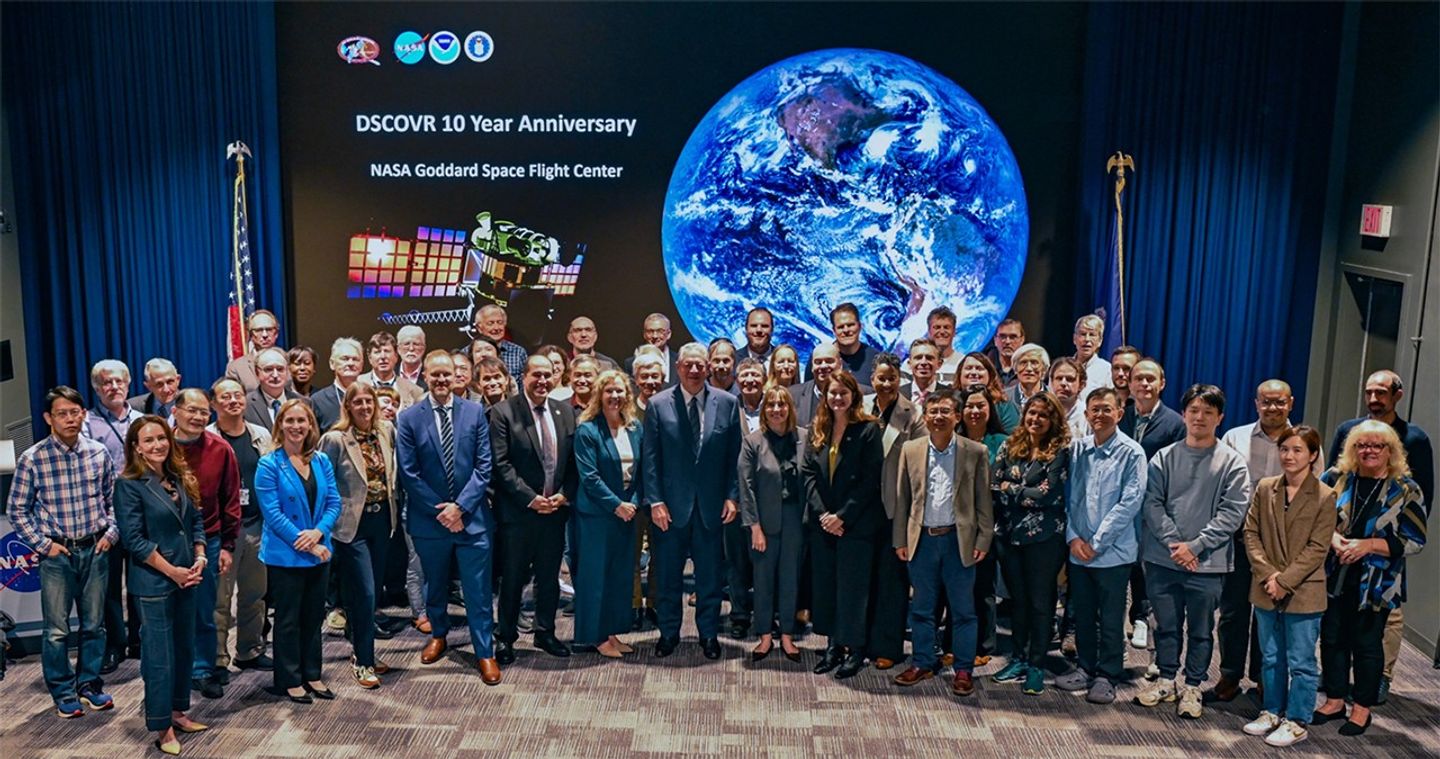
Updates on DSCOVR Operations
The DSCOVR mission components continue to function nominally. The meeting was an opportunity to update participants on progress over the past year on several fronts, including data acquisition, processing, and archiving, and release of new versions of several data products. The number of people using DSCOVR data continues to increase, with a new Science Outreach Team having been put in place to aid users in several aspects of data discovery, access, and user friendliness.
Amanda Raab [NOAA, DSCOVR Mission Operations and Systems] reported on the current status of the DSCOVR mission. She also discussed spacecraft risks and issues such as memory fragmentation and data storage task anomalies but indicated that both these issues have been resolved.
Hazem Mahmoud [NASA’s Langley Research Center (LaRC)] discussed the work of the Atmospheric Science Data Center (ASDC), which is based at LaRC. He showed DSCOVR mission metrics since 2015, focusing on data downloads and the global outreach of the mission. He noted that there has been a significant rise in the number of downloads and an increasing diversity of countries accessing ozone (O3), aerosol, and cloud data products. Mahmoud also announced that the ASDC is transitioning to the Amazon Web Services cloud, which will further enhance global access and streamline DSCOVR data processing.
Karin Blank [GSFC] covered the discovery of a new type of mirage that can only be seen in deep space from EPIC. The discussion included the use of a ray tracer in determining the origin of the phenomenon, and under what conditions it can be seen.
Alexander Cede [SciGlob] and Ragi Rajagopalan [LiftBlick OG] gave an overview of the stability of the EPIC Level-1A (L1A) data over the first decade of operation. They explained that the only observable changes in the EPIC calibration are to the dark count and flat field can – and that these changes can be entirely attributed to the temperature change of the system in orbit compared to prelaunch conditions. No additional hot or warm pixels have emerged since launch and no significant sensitivity drifts have been observed. The results that Cede and Rajagopalan showed that EPIC continues to be a remarkably stable instrument, which is attributed to a large extent to its orbit around the L1 point, which is located outside the Earth’s radiation belts and thus an extremely stable temperature environment. Consequently, in terms of stability, the L1 point is far superior to other Earth observation points, e.g., ground-based, low-Earth orbit (LEO), polar orbit, or geostationary Earth orbit (GEO).
Marshall Sutton [GSFC] discussed the state of the DSCOVR Science Operation Center (DSOC). He also talked about processing EPIC Level-1 (L1) data into L2 science products, daily images available on the EPIC website, and special imaging opportunities, e.g., volcanic eruptions.
EPIC Calibration
After 10 years of operation in space, the EPIC instrument on DSCOVR continues to be a remarkably stable instrument. The three presentations describe different ways that are used to verify the EPIC measurements remain reliable.
Conor Haney [LaRC] reported on anomalous outliers during February and March 2023 from the broadband shortwave (SW) flux using EPIC L1B channel radiances. To ensure that these outliers were not a result of fluctuations in the EPIC L1B channel radiances, both the EPIC radiance measurements and coincident, ray-matched radiance measurements from the Visible Infrared Imaging Radiometer Suite (VIIRS), on the Suomi National Polar-orbiting Partnership (Suomi NPP) platform, were processed using the same deep convective cloud invariant target (DCC-IT) algorithm. This analysis confirmed that the anomalous behavior was due to the DCC-IT algorithm – and not because of fluctuations in the EPIC L1B channel radiances. The improved DCC-IT methodology was also applied to the EPIC L1B radiances. The results indicate that the EPIC record is quite stable with a lower uncertainty than when processed using the previous DCC-IT methodology.
Igor Geogdzhaev [NASA’s Goddard Institute for Space Studies (GISS)/Columbia University] reported that EPIC Visible–Near Infrared (VIS-NIR) calibration based on VIIRS (on Suomi NPP) data has showed excellent stability, while VIIRS (on NOAA-20 and -21) derived gains agree to within 1–2%. Preliminary analysis showed continuity in the gains derived from Advanced Baseline Imager (ABI) data. (ABI flies on NOAA’s two operational Geostationary Operational Environmental Satellite–Series R satellites – GOES-17 and GOES-18.
Liang–Kang Huang [Science Systems and Applications, Inc. (SSAI)] reported on updates to the EPIC ultraviolet (UV) channel sensitivity time dependences using Sun-normalized radiance comparisons between EPIC and measurements from the Ozone Mapping and Profiler Suite (OMPS) Nadir Mapper (NM) on Suomi NPP, with coinciding footprints and solar/satellite angles. Huang’s team determined vignetting factors in the sensitivity calibration between 2021–2024, as a function of charge coupled device (CCD) pixel radius and pixel polar angles, using special lunar measurement sequences.
NISTAR Status and Science with Its Observations
The NISTAR instrument remains fully functional and continues its uninterrupted data record. The NISTAR-related presentations during this meeting included more details on specific topics related to NISTAR as well as on efforts to combine information from both EPIC and NISTAR.
Steven Lorentz [L-1 Standards and Technology, Inc.] reported that the NISTAR on DSCOVR has been measuring the irradiance from the sunlit Earth in three bands for more than nine years. The three bands measure the outgoing total and reflected-solar radiation from Earth at a limited range of solar angles. To compare the long-term stability of EPIC and NISTAR responses, researchers developed a narrowband to wideband conversion model to allow the direct comparison of the EPIC multiband imagery and NISTAR SW – see Figure 1 – and silicon photodiode channels. Lorentz presented daily results spanning several years. The comparison employed different detectors from the same spacecraft – but with the same vantage point – thereby avoiding any model dependent orbital artifacts.
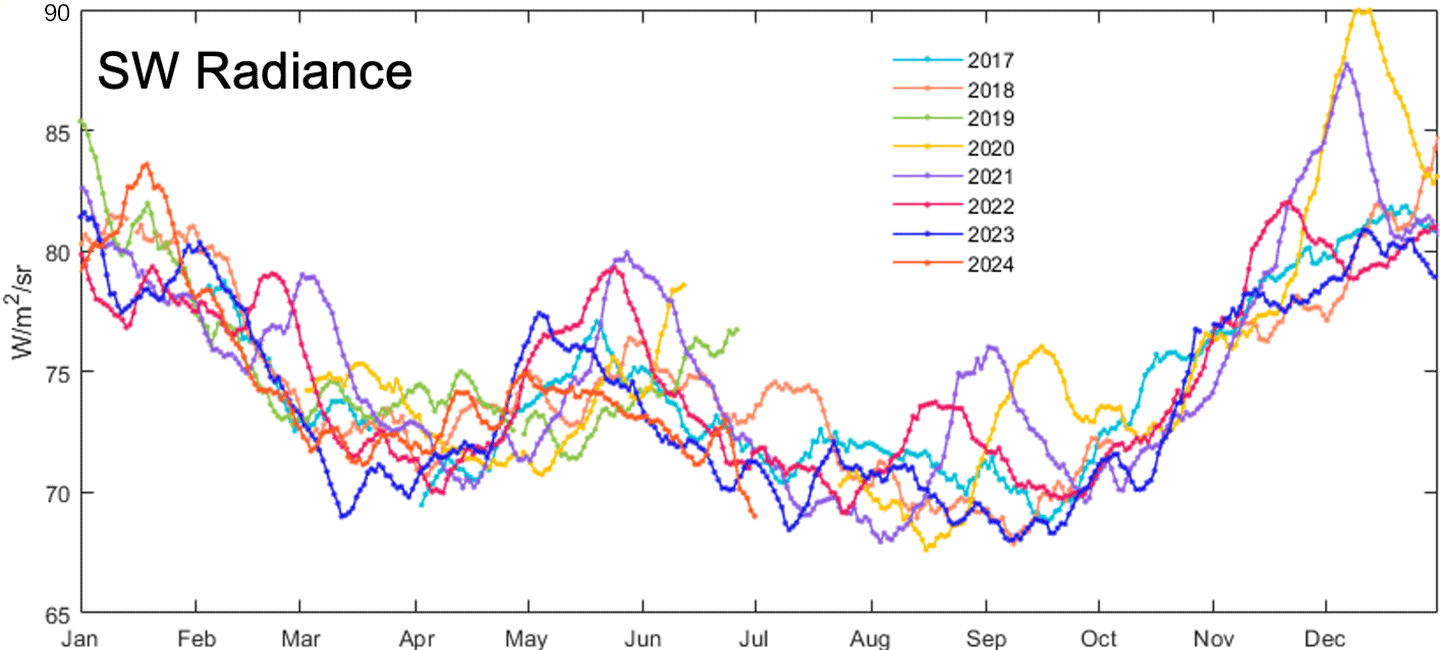
Clark Weaver [University of Maryland, College Park (UMD)] used spectral information from the SCanning Imaging Absorption spectroMeter for Atmospheric CartograpHY (SCIAMACHY), which flew on the European Space Agency’s (ESA) Envisat satellite from 2002–2012, to fill EPIC spectral gaps. He reported on construction of a composite height resolution spectrum that was spectrally integrated to produce SW energy. Weaver explained that he compared the EPIC reflected SW with four-hour averages from Band 4 on NISTAR. He used spectral information from SCIAMACHY to fill in gaps. Weaver also discussed results of a comparison of area integrated EPIC SW energy with observations from NISTAR .
Andrew Lacis [GISS] reported on results of analysis of seven years of EPIC-derived planetary albedo for Earth, which reveal global-scale longitudinal variability occurring over a wide range of frequencies – with strong correlation between nearby longitudes and strong anticorrelation between diametrically opposed longitudes. This behavior in the Earth’s global-scale energy budget variability is fully corroborated by seven years of NISTAR silicon photodiode measurements, which view the Earth with 1º longitudinal resolution. This analysis establishes the DSCOVR mission EPIC/NISTAR measurements as a new and unmatched observational data source for evaluating global climate model performance– e.g., see Figure 2.
Wenying Su [LaRC] discussed global daytime mean SW fluxes within the EPIC field of view produced from January 2016–June 2024. These quasi-hourly SW fluxes agree very well with the Synoptic data product from the Clouds and the Earth’s Radiant Energy System (CERES) instruments (currently flying on the Terra and Aqua, Suomi NPP, and NOAA-20 platforms) with the root mean square errors (rmse) less than 3 W/m2. This SW flux processing framework will be used to calculate NISTAR SW flux when Version 4 (V4) of the NISTAR radiance becomes available. Su noted that SW fluxes from EPIC are not suitable to study interannual variability as the magnitude of EPIC flux is sensitive to the percentage of daytime area visible to EPIC.
Update on EPIC Products and Science Results
EPIC has a suite of data products available. The following subsections summarize content during the DSCOVR STM related to these products. The updates focus on several data products and the related algorithm improvements.
Total Column Ozone
Jerry Ziemke [Morgan State University (MSU), Goddard Earth Sciences Technology and Research–II (GESTAR II)] and Natalya Kramarova [GSFC] reported that tropospheric O3 from DSCOVR EPIC shows anomalous reductions of ~10% throughout the Northern Hemisphere (NH) starting in Spring 2020 that continues to the present. The EPIC data, along with other satellite-based (e.g., Ozone Monitoring Instrument (OMI) on NASA’s Aura platform) and ground-based (e.g., Pandora) data, indicate that the observed NH reductions in O3 are due to combined effects from meteorology and reduced pollution, including reduced shipping pollution in early 2020 (during COVID) – see Figure 3. EPIC 1–2 hourly data are also used to evaluate hourly total O3 and derived tropospheric O3 from NASA’s Tropospheric Emissions: Monitoring of Pollution (TEMPO) geostationary instrument. Ziemke explained that comparison of TEMPO data with EPIC data has helped the researchers characterize a persistent latitude-dependent offset in TEMPO total O3 data of ~10–15% from south to north over the North American continent.
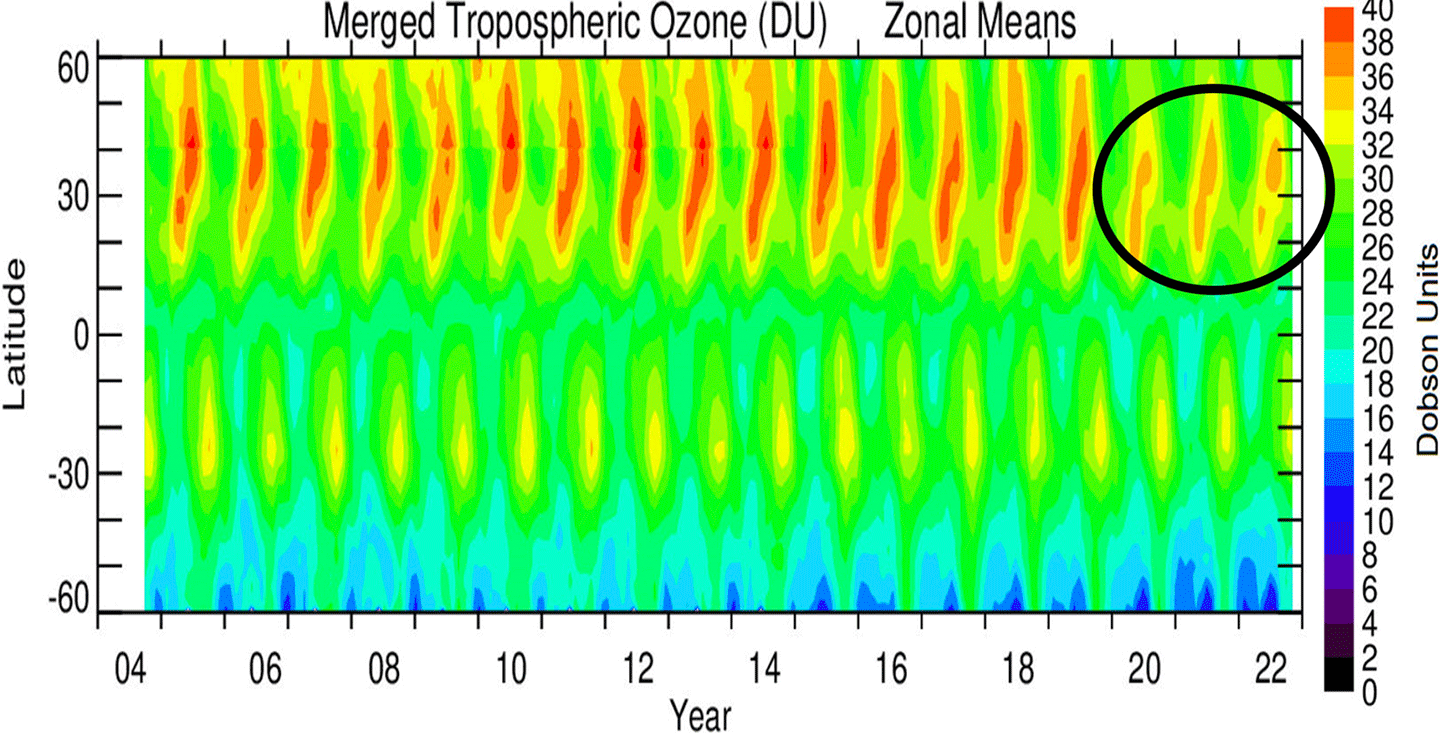
Algorithm Improvement for Ozone and Sulfur Dioxide Products
Kai Yang [UMD] presented a comprehensive evaluation of total and tropospheric O3 retrievals, highlighting the long-term stability and high accuracy of EPIC measurements. He also validated EPIC’s volcanic sulfur dioxide (SO2) retrievals by comparing them with ground-based Brewer spectrophotometer measurements and summarized EPIC’s observations of SO2 from recent volcanic eruptions.
Simon Carn [University of Michigan] showed the first comparisons between the EPIC L2 volcanic SO2 product and SO2 retrievals from the Geostationary Environment Monitoring Spectrometer (GEMS) on the Korean GEO-Kompsat-2B satellite. GEMS observes East Asia as part of the new geostationary UV air quality (GEO-AQ) satellite constellation (which also includes TEMPO that observes North America and will include the Ultraviolet–Visible–Near Infrared (UVN) instrument on the European Copernicus Sentinel-4 mission, that will be launched in 2025 to observe Europe and surrounding areas) – but is not optimized for measurements of high SO2 columns during volcanic eruptions. EPIC SO2 data for the 2024 eruption of Ruang volcano in Indonesia are being used to validate a new GEMS volcanic SO2 product. Initial comparisons show good agreement between EPIC and GEMS before volcanic cloud dispersal and confirm the greater sensitivity of the hyperspectral GEMS instrument to low SO2 column amounts.
Aerosols
Alexei Lyapustin [GSFC] reported that the latest EPIC aerosols algorithm (V3) simultaneously retrieves aerosol optical depth, aerosol spectral absorption, and aerosol layer height (ALH) – achieving high accuracy. He showed that global validation of the single scattering albedo in the blue and red shows 66% and 81–95% agreement respectively, with Aerosol Robotic Network (AERONET) observations – which is within the expected error of 0.03 for smoke and dust aerosols. Lyapustin also reported on a comparison of EPIC aerosol data collected from 2015–2023 by the Cloud-Aerosol Lidar with Orthogonal Polarization (CALIOP), which flew on the Cloud-Aerosol Lidar and Infrared Pathfinder Satellite Observations (CALIPSO) mission. The results show that ALH is retrieved with rmse ~1.1 km (0.7 mi). ALH is unbiased over the ocean and is underestimated by 450 m (1470 ft) for the smoke and by 750 m (2460 ft) for the dust aerosols over land.
Myungje Choi and Sujung Go [both from University of Maryland, Baltimore County’s (UMBC), GESTAR II] presented results from a global smoke and dust characterization using Multi-Angle Implementation of Atmospheric Correction (MAIAC) algorithm. This study characterized smoke and dust aerosol properties derived from MAIAC EPIC processing, examining spectral absorption, ALH, and chemical composition (e.g., black and brown carbon). Regions with smoldering wildfires, e.g., North America and Siberia, exhibited high ALH and a significant fraction of brown carbon, while Central Africa showed lower ALH with higher black carbon emissions.
Omar Torres [GSFC] discussed how L1 DSCOVR-EPIC observations are being used to study air quality (i.e., tropospheric O3 and aerosols) globally. Torres noted that this application of EPIC-L1 observations is of particular interest in the Southern Hemisphere (SH) where, unlike over the NH, there are currently no space GEO-based air quality measurements – and no plans for them in the foreseeable future.
Hiren Jethva [MSU, GESTAR II] presented the new results of the aerosol optical centroid height retrieved from the EPIC Oxygen-B band observations. He described the algorithm details, showed retrieval maps, and reviewed the comparative analysis against CALIOP backscatter-weighted measurements. The analysis showed a good level of agreement with more than 70% of matchup data within 1–1.5 km (0.6–0.9 mi) difference.
Jun Wang [University of Iowa] presented his team’s work on advancing the second generation of the aerosol optical centroid height (AOCH) algorithm for EPIC. Key advancements included: constraining surface reflectance in aerosol retrieval using an EPIC-based climatology of surface reflectance ratios between 442–680 nm; incorporating a dynamic aerosol model to characterize aged smoke particles; and employing a spectral slope technique to distinguish thick smoke plumes from clouds. Results show that both atmospheric optical depth (AOD) and AOCH retrievals are improved in the second generation of AOCH algorithm.
Olga Kalashnikova [NASA/Jet Propulsion Laboratory (JPL)] reported on improving brown carbon evolution processes in the Weather Research and Forecasting model coupled with Chemistry (WRF-Chem) model with EPIC products. She indicated that DSCOVR product evaluation, using lidar aerosol height measurements from CALIOP, led to an improved operational brown carbon product. To better resolve the temporal evolution of brown carbon, chemical transport models need to include more information about near-source fires.
Mike Garay [NASA/Jet Propulsion Laboratory (JPL)] discussed constraining near-source brown carbon emissions from 2024 Canadian ‘zombie’ fires with EPIC products. He reported that fires in British Columbia, Canada showed differences in brown carbon emission near the sources. Garay explained that their investigation has revealed that these differences were related to fire intensity and variations in vegetation/soil content.
Yuekui Yang [GSFC] presented work that examined the impact of Earth’s curvature consideration on EPIC cloud height retrievals. Biases under the Plane Parallel (PPL) assumption is studied by comparing results using the improved pseudo-spherical shell approximation. PPL retrievals in general bias high and for a cloud with height of 5 km (3 mi), the bias is about 6%.
Alfonso Delgado Bonal [UMBC] stated that the EPIC vantage point offers a unique opportunity to observe not only the current state of the Earth but also its temporal evolution. By capturing multiple observations of the planet throughout the day, EPIC enables statistical reconstruction of diurnal patterns in clouds and other atmospheric parameters. Bonal’s team focused their research on O3 (primarily tropospheric) over the U.S. to demonstrate the presence of a diurnal cycle in the western regions of the continental U.S. However, ground-based data from PANDORA for specific locations do not support these diurnal variations – underscoring the critical role of space-based O3 retrievals. The proposed methodology is not limited to clouds or O3 but is broadly applicable to other EPIC measurements for the dynamic nature of our planet.
Elizabeth Berry [Atmospheric and Environmental Research (AER)] presented results from a coincident DSCOVR–CloudSat dataset [covering 2015–2020]. Cloud properties (e.g., cloud height and optical depth) from DSCOVR and CloudSat are moderately correlated and show quite good agreement given differences in the instruments sensitivities and footprints. Berry explained that a machine-learning model trained on the coincident data demonstrates high accuracy at predicting the presence of vertical cloud layers. However, precision and recall metrics highlight the challenge of predicting the precise location of cloud boundaries.
Anthony Davis [JPL] presented a pathway toward accurate estimation of the cloud optical thickness (COT) of opaque clouds and cloud systems, e.g., supercells, mesoscale convective complexes, and tropical cyclones (TCs). He described the approach, which uses differential oxygen absorption spectroscopy (DOAS) that has resolving power greater than 104 – which is comparable to that of the high-resolution spectrometers on NASA’s Orbiting Carbon Observatory–2 (OCO-2) – but is based upon the cloud information content of EPIC’s O2 A- and B-band radiances. Unlike the current operational retrieval of COT – which uses data from the Moderate Resolution Imaging Spectroradiometer (MODIS) on Terra and Aqua – the DOAS-based technique does not saturate at COT exceeding ~60. According to a popular TC model with two-moment microphysics, COT in a tropical storm or hurricane can reach well into the hundreds, sometimes exceeding 1000. Davis said that once the new COT estimates become available, they will provide new observational constraints on process and forecast models for TCs.
Ocean
Robert Frouin [Scripps Institution of Oceanography, University of California] discussed ocean surface radiation products derived from EPIC data. He explained that significant advancements have been achieved in processing and evaluating ocean biology and biogeochemistry products derived from EPIC imagery. V1 updates enhanced accuracy by integrating Modern-Era Retrospective analysis for Research and Applications V2 (MERRA-2) ancillary data and refining calculations for atmospheric and surface parameters. Frouin introduced several diurnal products, including hourly photosynthetically active radiation (PAR) fluxes, spectral water reflectance, and chlorophyll-a concentrations. He said that these new MODIS-derived products have been validated through comparisons with data from the Advanced Himawari Imager on the Japanese Himawar–8 and –9 satellites. In order to address the gaps in these diurnal products, Frouin explained that the team developed a convolutional neural network that has been used effectively to reconstruct missing PAR values with high accuracy.
Vegetation
Yuri Knyazikhin [Boston University] reported on the status of the Vegetation Earth System Data Record (VESDR) that provides a variety of parameters including: Leaf Area Index (LAI), diurnal courses of Normalized Difference Vegetation Index (NDVI), Sunlit LAI (SLAI), Fraction of incident Photosynthetically Active Radiation (FPAR) absorbed by the vegetation, Directional Area Scattering Function (DASF), Earth Reflector Type Index (ERTI), and Canopy Scattering Coefficient (CSC). Knyazikhin discussed analysis of the diurnal and seasonal variations of these quantities. EPIC LAI and FPAR are consistent with MODIS-derived measurements of the same parameters.
Jan Pisek [University of Tartu/Tartu Observatory, Estonia] discussed efforts to derive leaf inclination information from EPIC data. The very first evaluation over Tumbarumba site (in New South Wales, Australia) showed that the angular variation in parameters obtained from EPIC reflects the expected variations due to the erectophile vegetation present at the site.
Sun Glint
Tamás Várnai [UMBC, JCET] discussed EPIC observations of Sun glint from ice clouds. The cloud glints come mostly from horizontally oriented ice crystals and have strong impact in EPIC cloud retrievals. Várnai reported that the EPIC glint product is available from the ASDC – see Figure 4. Glint data can help reduce the uncertainties related to horizontally oriented ice crystals and yield additional new insights about the microphysical and radiative properties of ice clouds.
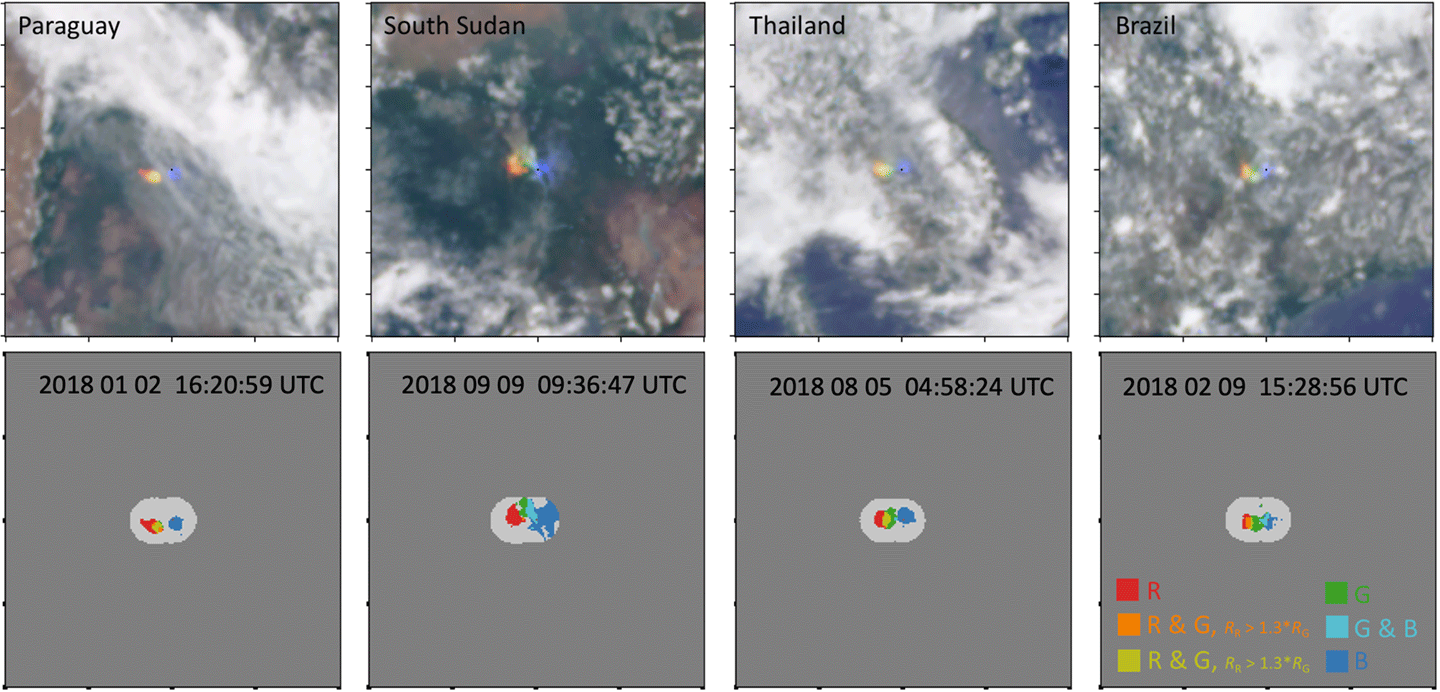
Alexander Kostinski [Michigan Technology University] explained that because they detected climatic signals (i.e., longer-term changes and semi-permanent features, e.g., ocean glitter), they developed a technique to suppress geographic “noise” in EPIC images that involves introducing temporally (monthly) and conditionally (classifying by surface/cover type, e.g., land, ocean, clouds) averaged reflectance images – see Figure 5. The resulting images display seasonal dependence in a striking manner. Additionally, cloud-free, ocean-only images highlight prominent regions of ocean glitter.
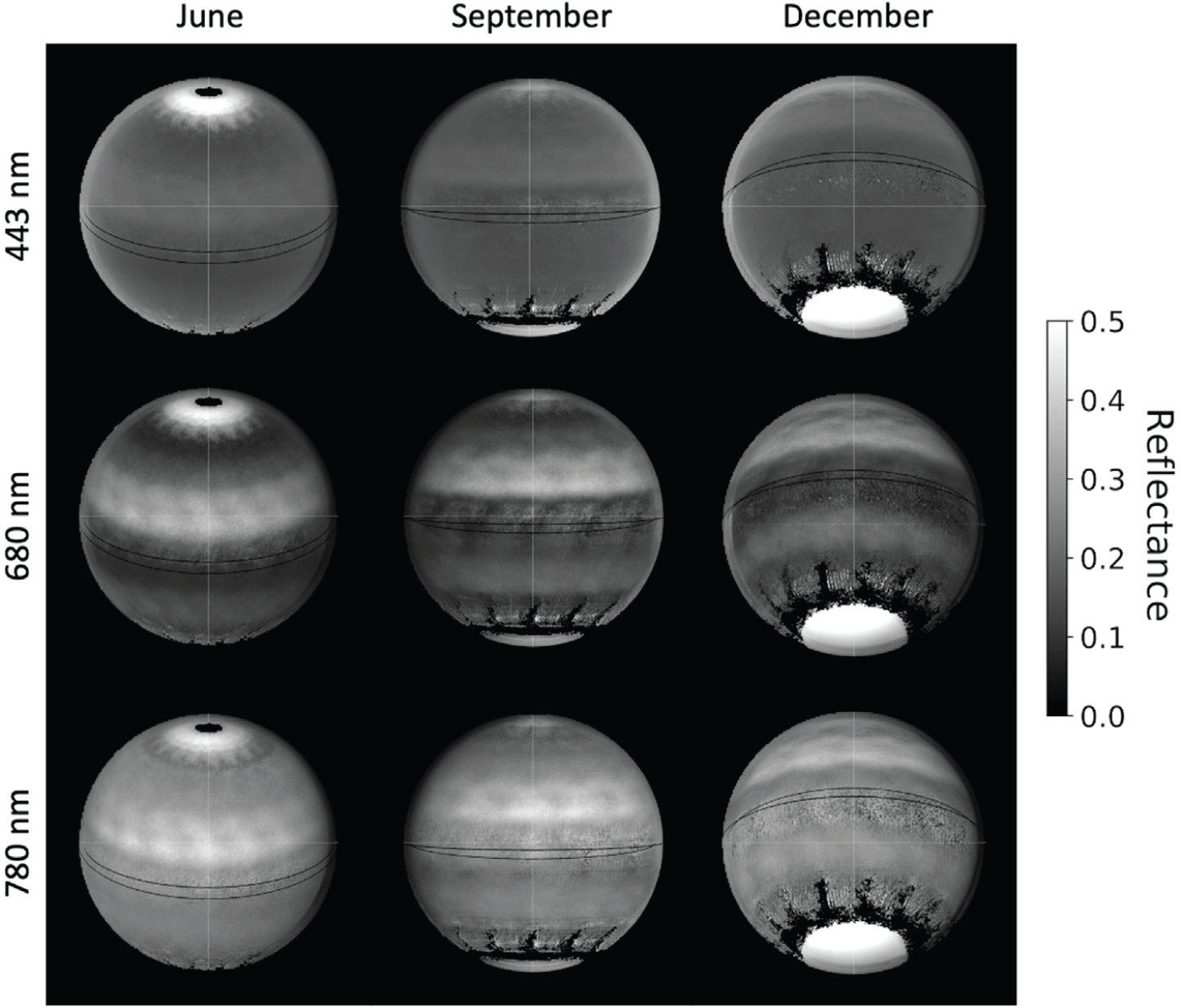
Jiani Yang [Caltech] reported that spatially resolving light curves from DSCOVR is crucial for evaluating time-varying surface features and the presence of an atmosphere. Both of these features are essential for sustaining life on Earth – and thus can be used to assess the potential habitability of exoplanets. Using epsilon machine reconstruction, the statistical complexity from the time series data of these light curves can be calculated. The results show that statistical complexity serves as a reliable metric for quantifying the intricacy of planetary features. Higher levels of planetary complexity qualitatively correspond to increased statistical complexity and Shannon entropy, illustrating the effectiveness of this approach in identifying planets with the most dynamic characteristics.
Other EPIC Science Results
Guoyong Wen [MSU, GESTAR II] analyzed the variability of global spectral reflectance from EPIC and the integrated broadband reflectance on different timescales. He reported that on a diurnal timescale, the global reflectance variations in UV and blue bands are statistically similar – and drastically different from those observed in longer wavelength bands (i.e., green to NIR). The researchers also did an analysis of monthly average results and found that temporal averaging of the global reflectance reduces the variability across the wavelength and that the variability of broadband reflectance is similar to that for the red band on both timescales. These results are mainly due to the rotation of the Earth on diurnal timescale and the change of the Earth’s tilt angle.
Nick Gorkavyi [Science Systems and Applications, Inc. (SSAI)] reported that EPIC – located at the L1 point, 1.5 million km (0.9 million mi) away from Earth – can capture images of the far side of the Moon in multiple wavelengths. These images, taken under full solar illumination, can be used to calibrate photographs obtained by lunar artificial satellites. Additionally, he discussed the impact of lunar libration – the changing view of the Moon from Earth, or it’s apparent “wobble” – on Earth observations from the Moon.
Jay Herman [UMBC] discussed a comparison of EPIC O3 with TEMPO satellite and Pandora ground-based measurement. The results show that total column O3 does not have a significant photochemical diurnal variation. Instead, the daily observed diurnal variation is caused by weather changes in atmospheric pressure. This measurement result agrees with model calculations.
Conclusion
Alexander Marshak, Jay Herman, and Adam Szabo led a closing discussion with ST participants on how to make the EPIC and NISTAR instruments more visible in the community. It was noted that the EPIC website now allows visitors to observe daily fluctuations of aerosol index, cloud fraction, cloud height, and the ocean surface – as observed from the L1 point. More daily products, (e.g., aerosol height and sunlit leaf area index) will be added soon, which should attract more users to the website.
Overall, the 2023 DSCOVR EPIC and NISTAR STM was successful. It provided an opportunity for participants to learn the status of DSCOVR’s Earth-observing instruments, EPIC and NISTAR, the status of recently released L2 data products, and the science results being achieved from the L1 point. As more people use DSCOVR data worldwide, the ST hopes to hear from users and team members at its next meeting. The latest updates from the mission can be found on the EPIC website.
Alexander Marshak
NASA’s Goddard Space Flight Center
alexander.marshak@nasa.gov
Adam Szabo
NASA’s Goddard Space Flight Center
adam.szabo@nasa.gov
2 min read

Earth planning date: Wednesday, Feb. 12, 2025
I woke up this morning to my weather app telling me it felt like minus 15° C (5°F) outside. On days like this, it can take me a little longer to get myself up and out into the world. Curiosity has a similar problem — as we head toward winter and it gets colder and colder in Gale Crater, Curiosity has to spend more time warming up to do things like driving and all our good science. I’ve also been watching a couple winter storms that are expected in the next few days here in Toronto. Luckily, Curiosity doesn’t have to deal with snowstorms, and our drive in the last plan went ahead as planned and put us in a good position to go ahead with contact science today, a relief after having to forego it on Monday.
The contact science location that the geology team chose is called “Catalina Island,” the flat rock you can see in almost the center of the image above. As you can likely also see above, there’s a whole jumble of rocks in that image, and Mastcam and ChemCam have picked out a couple others to take a look at. These are “Point Dume,” which will be the target of ChemCam’s laser spectrometer, and “Whittier Narrows,” on which Mastcam will image some linear features. Mastcam and ChemCam are also turning their gazes further afield for Mastcam targets “Cleghorn Ridge,” “Cuyamaca Peak,” “Kratka Ridge,” and two long-distance ChemCam mosaics of the top of the Wilkerson butte and a spot a little further down known as “Pothole Trail.”
Much like I’m keeping an eye out the window on the changing weather here, Curiosity is also continuing to keep an eye on the environment in Gale Crater. Even though it’s not the dusty season, we continue to monitor the dust around us and in the atmosphere with a dust-devil survey and a tau. But we’re especially interested in what the clouds are up to right now, which we’re checking in on with our normal zenith and suprahorizon movies, and our cloud-season-only Phase Function Sky Survey. This is a series of movies covering the whole sky that we can use to determine how sunlight interacts with the individual water-ice crystals in the clouds.
Written by Alex Innanen, Atmospheric Scientist at York University
Mars is the fourth planet from the Sun, and the seventh largest. It’s the only planet we know of inhabited…
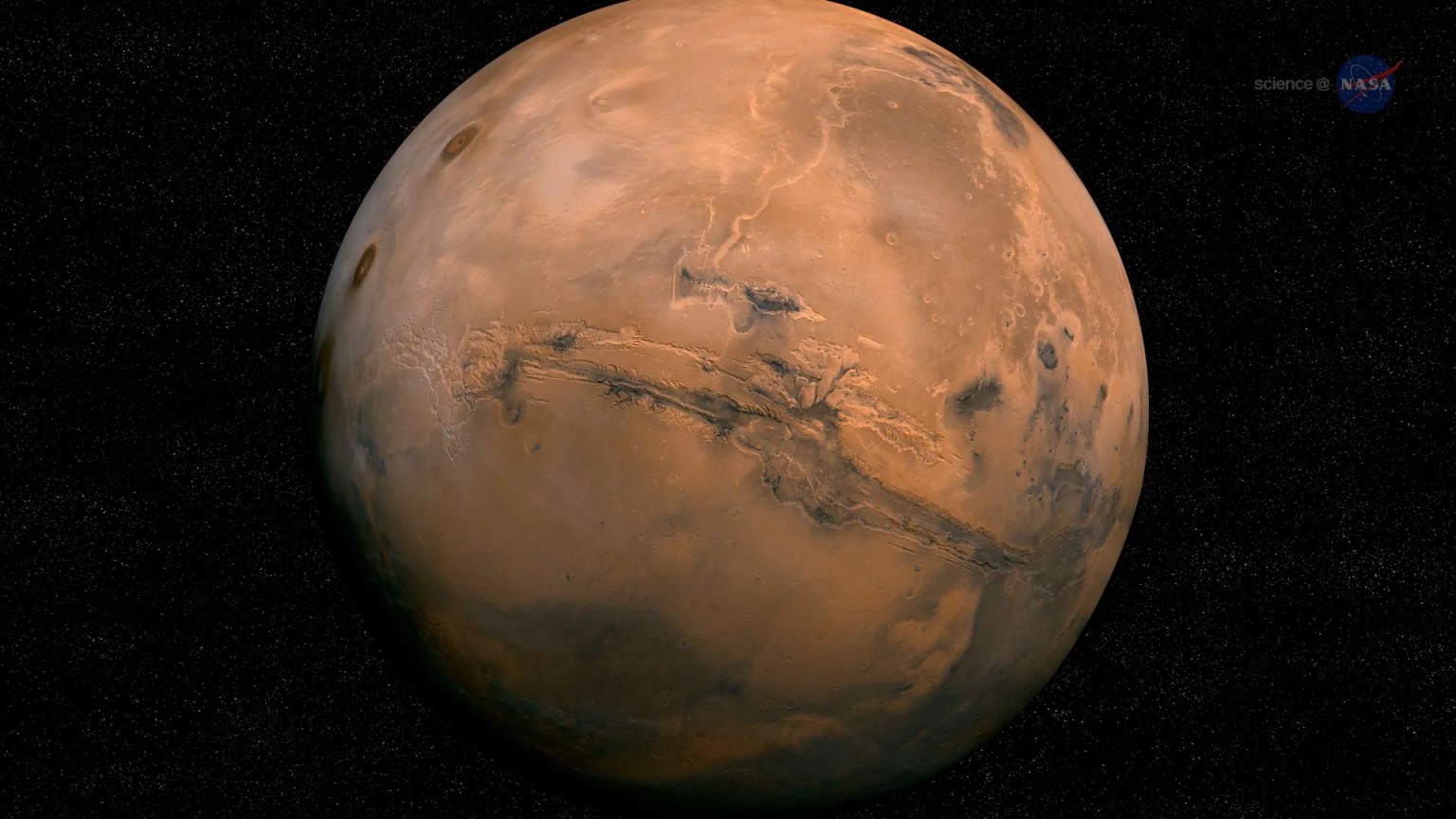
Explore this collection of Mars images, videos, resources, PDFs, and toolkits. Discover valuable content designed to inform, educate, and inspire,…
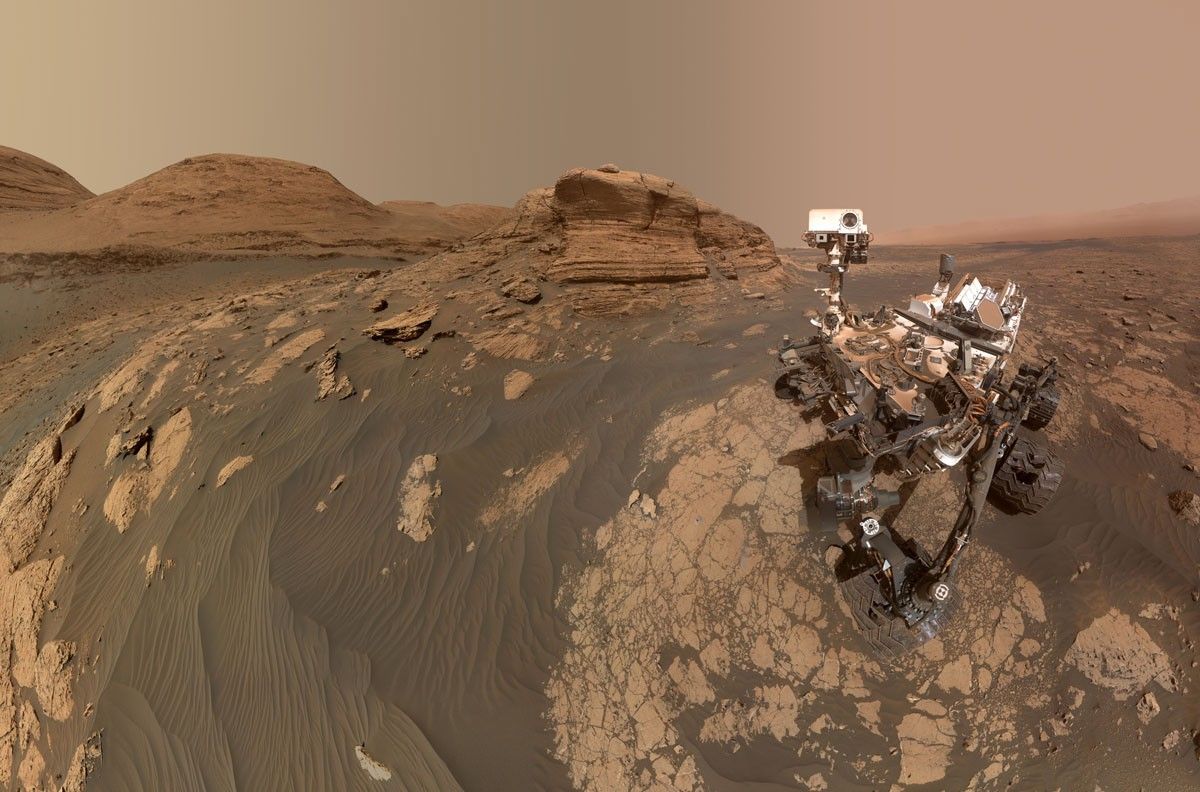
Each robotic explorer sent to the Red Planet has its own unique capabilities driven by science. Many attributes of a…
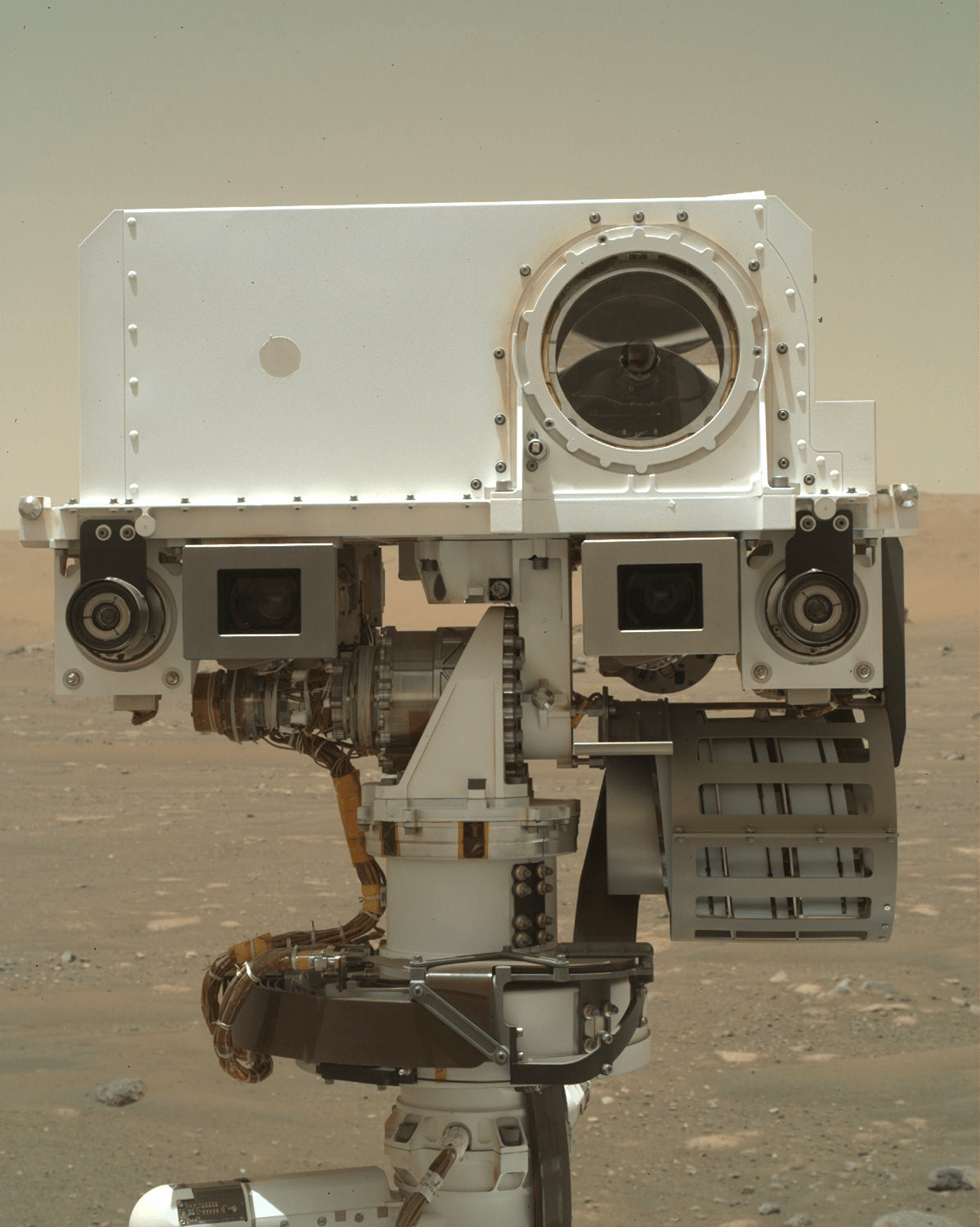
The key to understanding the past, present or future potential for life on Mars can be found in NASA’s four…
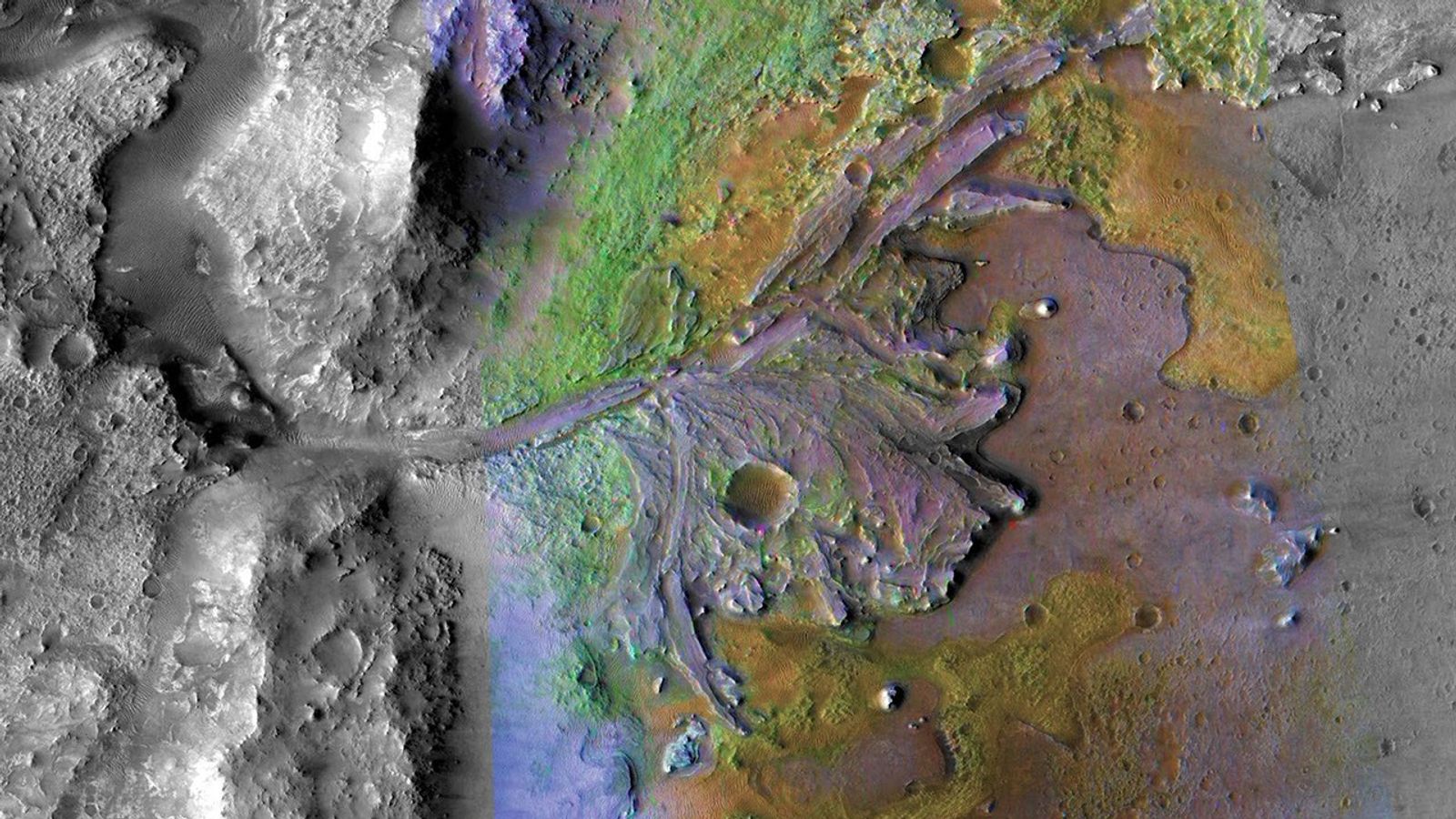
The Department of Education has been a boondoggle since its inception.
Education should be done at the local and state level. Parents should be in charge of the education of their children, whether in private school or public school. The reality is that the more local the education, the more it reflects the needs, desires, and wants of the parents, who, of course, are the ones most aligned with the interests of their children.
Instead, we in the United States have increasingly devolved authority to the federal government. Virtually all of the agencies have been hijacked — as we’ve now been learning — by a Left-wing bureaucratic mess designed to be a permanent pipeline of cash to the friends of the Democrats.
This is particularly true of the Department of Education. In fiscal year 2024, the Department of Education spent $268 billion. That is a lot of money. And since 1980, the spending has increased 372%, which is almost double the increase of the size of the rest of the federal government’s.
Most of that goes to subsidize precisely the sort of indoctrination centers that have been churning out radicals in extraordinary numbers, corrupting our body politic for decades.
If you did not like the Hamas Tentifadas on campus last year, you can blame the fact that we as a society decided it was deeply imperative to send all of our teenagers to institutions of higher education that indoctrinate them in trash. You can blame that on the fact that our primary, lower, and secondary education institutions have been indoctrinating kids in Left-wing values for decades.
Last year, the Department of Education spent $165 billion on higher education. That’s nearly half the total funds spent by the entire department. That money went to colleges and universities to prop up the great scam that is higher education. Those are grants to students to major in lesbian dance theory.
You’re wondering, how did they get that money? The answer is you got to pay for it. Just $40 billion went directly to elementary and secondary education. Even if you wanted the money going to small kids, it is not predominantly going to them. It is going to the very large overgrown children who are 19 and 20 years old, majoring in nonsense.
The dollars went indirectly to the lower level, to the grifters and cretins of the unions, like the American Federation of Teachers (AFT) and the National Education Association (NEA). It did not flow directly to them, but when federal dollars subsidize schools that are in bed with the AFT and the NEA, the work of Randi Weingarten is subsidized.
What have been the priorities of the Department of Education in the recent past? Joe Biden’s Secretary of Education, Miguel Cardona, wrote in last year’s budget summary, “The investments proposed in President Biden’s new budget reflect this Administration’s deep belief in education as the foundation of all opportunity in America. … The President’s budget would also expand career-connected learning in our schools and provide more pathways to well-paying careers, as well as raise the bar for college affordability, inclusive student success, and driving more equitable outcomes in higher education.”
Equity, of course, is effectively a code word for racial quotas. That’s how Biden saw it. Biden requested $100 million for developing and implementing strategies to promote diversity in schools and classrooms. But that is not just in reference to racial quotas; it is in reference to the curriculum itself — to what is taught.
President Trump came into office pledging to kill DEI programs at our nation’s schools. The Department of Education has apparently handed out $1 billion in DEI grants since 2021 alone, according to Parents Defending Education. That included $490 million in grants for race-based hiring schemes, which are illegal under the Constitution; $169 million for DEI-based mental health training; and $343 million on general DEI programs. That’s just over the past few years.
So what exactly did the Biden administration do after the Supreme Court banned affirmative action last year? The DOE then released resources to assist colleges and universities to basically end-around the law. You remember: Joe Biden tried to do this.
On August 14th, 2023, the Biden administration issued what was called the “Dear Colleague” letter, an advisory letter from the federal government to a variety of institutions designed to tell them how they wanted the law applied. The goal, apparently, was to substitute mushy words like “overcoming adversity” for explicit racial quotas.
Assistant Secretary for Civil Rights at ED Catherine E. Lhamon wrote, “Even after the Court’s decision sharply limited a tool that colleges and universities with selective admissions practices have used to create vibrant, diverse campus communities, colleges and universities may still lawfully work to admit, support, retain, and graduate racially diverse student bodies. Today’s resources explain practices that remain legally viable and confirms the Federal government’s robust civil rights protections in schools.”
In other words, ignore the Supreme Court.
People who keep shouting about Trump and constitutional crises ignored the Supreme Court of the United States, openly and basically saying they would defy the Supreme Court in pursuit of their diversity agenda.
There is no bigger boondoggle than the Department of Education, which is why they are screaming bloody murder over what Trump is doing.
These public sector teachers unions, in many states, collect union dues from their teachers, and then pay off Democratic politicians with those dues. They campaign for Democrats. Democrats then sign massive, ridiculous pork-laden contracts with the AFT to enrich everybody; then, the AFT does it all over again. That’s the game.
Does the AFT care about students? Of course not. They are not a priority. We learned just as much during COVID when the AFT pushed incredibly hard for students never to go back to school, claiming they weren’t safe.
Randi Weingarten said that despite every piece of evidence, you couldn’t let your kids go back to school to die of COVID. It didn’t matter that a paucity of children were dying of COVID. All that mattered to Weingarten was that her teachers got to stay home, teach on Zoom, and still get paid their salaries.
The tale that Democrats are trying to tell is that your kid is going to lose their cherished public school education because Trump wants to kill the Department of Education.
But the vast majority of funding for public school in the United States comes at the state and local levels. It is not coming from the federal government.
What comes from the federal government is very often attached to precisely the kinds of interest groups to which the Democrats want it attached.
Former Biden Education Secretary Cardona has claimed that what Trump is doing is a form of monarchy. He said, “I’m all in favor of reviewing what works best, and I’m even in favor of assessing policy, whether you agree with it or not. But I’m not in favor of the change that’s happening, which is going from democracy to a monarchy. And we’re seeing examples of that in every agency. And it’s really troubling. And I think the American people, regardless of party, should be worried about what’s happening now.”
He’s lying. He’s not in favor of auditing anything. He’s not in favor of checking out the curriculum.
According to Democrats, when a regulatory, bureaucratic agency pumps out $300 billion a year to the friends of Cardona, that’s called democracy. But it’s monarchy when the new president comes in and says we’re not doing that anymore.
Whatever you want to call it, give me more of it.

Fundraising messages centered around President Donald Trump have continued to dominate on both sides of the political aisle since his return to the White House.
The Democrats' messages revolve around voicing their opposition to Trump’s second term, his executive orders, and action by the Department of Government Efficiency (DOGE), which has become a cornerstone of Trump’s first month back in the Oval Office.
"Americans are starting to feel the disastrous effects of a Trump-Musk presidency, and we see that sentiment reflected in our top-performing messaging, which highlights the need to fight the extremes of Donald Trump and prepare for elections this year, in 2026 and beyond," DNC Senior Spokesperson Hannah Muldavin told Fox News Digital.
Muldavin said the DNC's most effective fundraising messages have centered around "the extremes of Donald Trump."
"Our most effective outreach to grassroots supporters right now comes from our new Chair Ken Martin, who talks about not just fighting the extremes of Donald Trump, but also on making the case to working families in both red and blue states that Democrats are the party fighting for them," Muldavin added.
The Democratic National Committee’s website opened this week to a photo of Ken Martin, newly elected DNC Chair, with a simple message: "Ken Martin is the new DNC Chair. Help Democrats mobilize against Trump." A fundraising message on the donation page invites Democrats to "pitch in to the DNC and help elect Democrats nationwide."
"The DNC is the organization best positioned to fight back, organize, and stop the worst impulses of a Trump administration. So please don’t wait: donate now to elect Democrats who will fight back against the MAGA agenda," the message says.
The Democratic Congressional Campaign Committee has a similar strategy with a down-ballot focus. On the DCCC website, a photo of House Minority Leader Hakeem Jeffries appears next to a fundraising message inviting supporters to "become a majority maker."
"At the DCCC, we're laser-focused on the midterms and taking back the House from the MAGA Majority," the message says. "With just THREE seats standing between us and the Majority, your monthly donation will help us do everything we can to flip the House blue and build a firewall against the Trump Trifecta. Will you make a recurring monthly donation to the DCCC to fuel our work today?"
Trump’s fundraising apparatus has also capitalized on his return to center stage. Trump National Committee, the joint super PAC of Never Surrender and the Republican National Committee, have maintained consistent fundraising outreach since Trump’s election victory.
"Trump is the center of the universe at the moment," Republican strategist Matt Gorman, who worked on Senator Tim Scott’s presidential campaign and as communications director for the National Republican Congressional Committee, told Fox News Digital. "It's been pretty well proven over the last decade that Trump animates the fundraising base of both parties and utilizing him is an effective strategy."
As soon as Nov. 6, just a day after the election, a message "from Trump" to his supporters read, "TOTAL VICTORY! Because of you, WE WON!" with a link to donate to Trump’s super PAC. The messages continued in the weeks and months leading up to his inauguration.
The tone of the messages took a turn after Democrat Rep. Al Green, D-T.X., who attempted to impeach Trump three times during his first term, announced that he would file articles of impeachment against the president for saying he would "take over" Gaza.
Green said on the House floor the next day that Israeli Prime Minister Benjamin Netanyahu "should be ashamed, knowing the history of his people, to stand there and allow such things to be said."
"Before Democrats introduce Articles of Impeachment, can you answer question #1?" a fundraising message from Trump's super PAC asked the next day.
Then last week, the PAC sent a message from Vice President JD Vance that read, "Don't pee on my boots & tell me it's raining. It's JD Vance. These are the top lies I've seen from Democrats."
"Democrats don’t have any policies. All they have is lies. Nobody believes their crap. So on behalf of every American who is sick of their lies, I got one thing to say: Don’t pee on my boots & tell me it’s raining. Democrats can’t stand that we have a President who’s putting the working men & women of America first, AND NOW THEY’RE THREATENING TO IMPEACH TRUMP AGAIN!"
The message from Republicans is clear: Democrats do not have policies beyond resisting Trump.
"Their identity for the last ten years has been, simply, 'Whatever Trump is for, I'm against,'" Gorman said.
While using Trump’s name can be an effective fundraising strategy, Gorman urged candidates to move past the moniker and step into policy discussions as well.
"Policy is really important, too. Every candidate has to articulate what they stand for, how they'd be different from their opponent and what they bring to Washington or to the statehouse. Trump is helpful in every aspect, but it's important to make sure you're defining what you would do in your policies as well."
